Related Research Articles
Pulp magazines were inexpensive fiction magazines that were published from 1896 until around 1955. The term "pulp" derives from the cheap wood pulp paper on which the magazines were printed. In contrast, magazines printed on higher-quality paper were called "glossies" or "slicks". The typical pulp magazine had 128 pages; it was 7 inches (18 cm) wide by 10 inches (25 cm) high, and 0.5 inches (1.3 cm) thick, with ragged, untrimmed edges. Pulps were the successors to the penny dreadfuls, dime novels, and short-fiction magazines of the 19th century.

Papermaking is the manufacture of paper and cardboard, which are used widely for printing, writing, and packaging, among many other purposes. Today almost all paper is made using industrial machinery, while handmade paper survives as a specialized craft and a medium for artistic expression.

Newsprint is a low-cost, non-archival paper consisting mainly of wood pulp and most commonly used to print newspapers and other publications and advertising material. Invented in 1844 by Charles Fenerty of Nova Scotia, Canada, it usually has an off white cast and distinctive feel. It is designed for use in printing presses that employ a long web of paper, rather than individual sheets of paper.
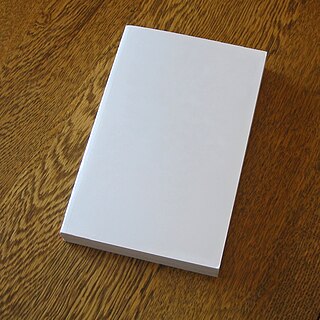
A paperback book is one with a thick paper or paperboard cover, and often held together with glue rather than stitches or staples. In contrast, hardback (hardcover) books are bound with cardboard covered with cloth, leather, paper, or plastic.

Amazing Stories is an American science fiction magazine launched in April 1926 by Hugo Gernsback's Experimenter Publishing. It was the first magazine devoted solely to science fiction. Science fiction stories had made regular appearances in other magazines, including some published by Gernsback, but Amazing helped define and launch a new genre of pulp fiction.

Argosy was an American magazine, founded in 1882 as The Golden Argosy, a children's weekly, edited by Frank Munsey and published by E. G. Rideout. Munsey took over as publisher when Rideout went bankrupt in 1883, and after many struggles made the magazine profitable. He shortened the title to The Argosy in 1888 and targeted an audience of men and boys with adventure stories. In 1894 he switched it to a monthly schedule and in 1896 he eliminated all non-fiction and started using cheap pulp paper, making it the first pulp magazine. Circulation had reached half a million by 1907, and remained strong until the 1930s. The name was changed to Argosy All-Story Weekly in 1920 after the magazine merged with All-Story Weekly, another Munsey pulp, and from 1929 it became just Argosy.

Men's adventure is a genre of magazine that was published in the United States from the 1940s until the early 1970s. Catering to a male audience, these magazines featured pin-up girls and lurid tales of adventure that typically featured wartime feats of daring, exotic travel or conflict with wild animals. These magazines were also colloquially called "armpit slicks", "men's sweat magazines" or "the sweats", especially by people in the magazine publishing or distribution trades.

Tissue paper or simply tissue is a lightweight paper or, light crêpe paper. Tissue can be made from recycled paper pulp on a paper machine.

A science fiction magazine is a publication that offers primarily science fiction, either in a hard-copy periodical format or on the Internet. Science fiction magazines traditionally featured speculative fiction in short story, novelette, novella or novel form, a format that continues into the present day. Many also contain editorials, book reviews or articles, and some also include stories in the fantasy and horror genres.
Coated paper is paper that has been coated by a mixture of materials or a polymer to impart certain qualities to the paper, including weight, surface gloss, smoothness, or reduced ink absorbency. Various materials, including kaolinite, calcium carbonate, bentonite, and talc, can be used to coat paper for high-quality printing used in the packaging industry and in magazines.
Cotton paper, also known as rag paper or rag stock paper, is made using cotton linters or cotton from used cloth (rags) as the primary material. Prior to the mid-19th century, cotton paper was the main form of paper produced, with pulp paper replacing cotton paper as the main paper material during the 19th century. Although pulp paper was cheaper to produce, its quality and durability is significantly lower. Although pulp-paper quality improved significantly over the 20th century, cotton paper continues to be more durable, and consequently important documents are often printed on cotton paper. Different grades of cotton paper can be produced.
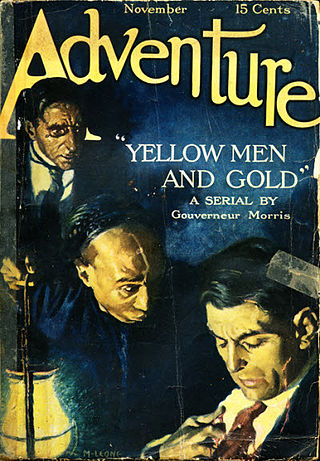
Adventure was an American pulp magazine that was first published in November 1910 by the Ridgway company, a subsidiary of the Butterick Publishing Company. Adventure went on to become one of the most profitable and critically acclaimed of all the American pulp magazines. The magazine had 881 issues. Its first editor was Trumbull White. He was succeeded in 1912 by Arthur Sullivant Hoffman (1876–1966), who edited the magazine until 1927.

Paper is a thin sheet material produced by mechanically or chemically processing cellulose fibres derived from wood, rags, grasses, or other vegetable sources in water, draining the water through a fine mesh leaving the fibre evenly distributed on the surface, followed by pressing and drying. Although paper was originally made in single sheets by hand, almost all is now made on large machines—some making reels 10 metres wide, running at 2,000 metres per minute and up to 600,000 tonnes a year. It is a versatile material with many uses, including printing, painting, graphics, signage, design, packaging, decorating, writing, and cleaning. It may also be used as filter paper, wallpaper, book endpaper, conservation paper, laminated worktops, toilet tissue, currency, and security paper, or in a number of industrial and construction processes.

Science-Fiction Plus was an American science fiction magazine published by Hugo Gernsback for seven issues in 1953. In 1926, Gernsback had launched Amazing Stories, the first science fiction magazine, but he had not been involved in the genre since 1936, when he sold Wonder Stories. Science-Fiction Plus was initially in slick format, meaning that it was large-size and printed on glossy paper. Gernsback had always believed in the educational power of science fiction, and he continued to advocate his views in the new magazine's editorials. The managing editor, Sam Moskowitz, had been a reader of the early pulp magazines, and published many writers who had been popular before World War II, such as Raymond Z. Gallun, Eando Binder, and Harry Bates. Combined with Gernsback's earnest editorials, the use of these early writers gave the magazine an anachronistic feel.
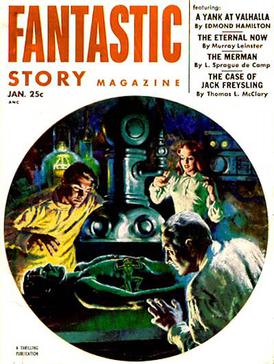
Fantastic Story Quarterlywas a pulp science fiction magazine, published from 1950 to 1955 by Best Books, a subsidiary imprint of Standard Magazines, based in Kokomo, Indiana. The name was changed with the Summer 1951 issue to Fantastic Story Magazine. It was launched to reprint stories from the early years of the science fiction pulp magazines, and was initially intended to carry no new fiction, though in the end every issue contained at least one new story. It was sufficiently successful for Standard to launch Wonder Story Annual as a vehicle for more science fiction reprints, but the success did not last. In 1955 it was merged with Standard's Startling Stories. Original fiction in Fantastic Story included Gordon R. Dickson's first sale, "Trespass", and stories by Walter M. Miller and Richard Matheson.
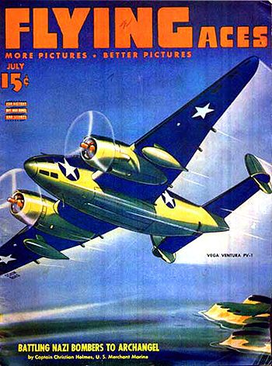
Flying Aces was a monthly American periodical of short stories about aviation, one of a number of so-called "flying pulp" magazines popular during the 1920s and 1930s. Like other pulp magazines, it was a collection of adventure stories, originally printed on coarse, pulpy paper but later moved to a slick format. The magazine was launched in October 1928 by Periodical House, Inc. It featured stories written and illustrated by known authors of the day, often set against the background of World War I. Later issues added non-fiction aviation articles, as well as articles and plans for model airplanes. The latter became more prominent, and eventually the magazine was renamed Flying Models, and catered exclusively to aeromodeling hobbyists.
Stephen Gould Fisher was an American author best known for his pulp stories, novels and screenplays. He is one of the few pulp authors to go on to enjoy success as both an author in "slick" magazines, such as the Saturday Evening Post, and as an in-demand writer in Hollywood.
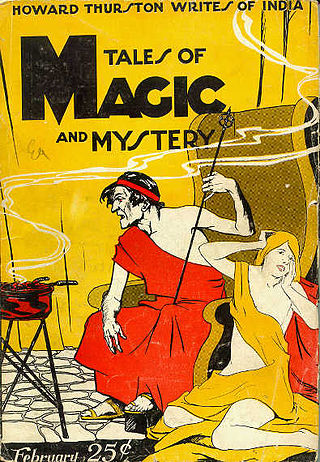
Tales of Magic and Mystery was a pulp magazine which published five monthly issues from December 1927 to April 1928. It was edited by Walter Gibson, and published a mixture of fiction and articles on magic. It is now mainly remembered for having published a story by H.P. Lovecraft.

Ghost Stories was an American pulp magazine that published 64 issues between 1926 and 1932. It was one of the earliest competitors to Weird Tales, the first magazine to specialize in the fantasy and occult fiction genre. It was a companion magazine to True Story and True Detective Stories, and focused almost entirely on stories about ghosts, many of which were written by staff writers but presented under pseudonyms as true confessions. These were often accompanied by faked photographs to make the stories appear more believable. Ghost Stories also had original and reprinted contributions, including works by Robert E. Howard, Carl Jacobi, and Frank Belknap Long. Among the reprints were Agatha Christie's "The Last Seance", several stories by H.G. Wells, and Charles Dickens's "The Signal-Man". Initially successful, the magazine began to lose readers and in 1930 was sold to Harold Hersey. Hersey was unable to reverse the magazine's decline, and publication of Ghost Stories ceased in early 1932.
References
- Earle, David M. (2009). Re-Covering Modernism: Pulps, Paperbacks, and the Prejudice of Form. Farnham, England: Ashgate Publishing. ISBN 978-0-7546-6154-2.